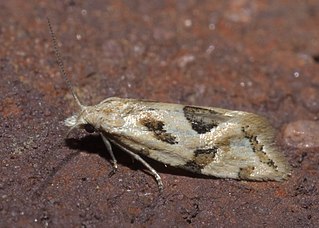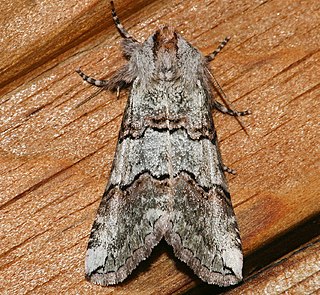Chlorobaptella is a monotypic moth genus of the family Crambidae erected by Eugene G. Munroe in 1995. Its only species, Chlorobaptella rufistrigalis, was first described by William Barnes and James Halliday McDunnough in 1914. It is found in North America, where it has been recorded from California and Nevada. Moths in this genus are distinguished from moths in similar genera by their small palpi and obsolete tongues.
Chrismania is a monotypic moth genus of the family Crambidae. Its only species, Chrismania pictipennalis, is found in North America, where it has been recorded from southern California and Arizona. Both the genus and species were first described by William Barnes and James Halliday McDunnough in 1914.

Grotella citronella is a species of moth in the genus Grotella, of the family Noctuidae. This moth is found in North America, including the Mojave Desert region of California. This species was first described by William Barnes and James Halliday McDunnough in 1916.
Renia nemoralis, the tardy renia or chocolate renia moth, is a litter moth of the family Erebidae. It is found in the US from Illinois to south-eastern Massachusetts south to Florida and Texas. The species was first described by William Barnes and James Halliday McDunnough in 1918.

Aethes is a genus of moths belonging to the subfamily Tortricinae of the family Tortricidae.

Euphilotes rita, the rita blue or desert buckwheat blue, is a species of butterfly of the family Lycaenidae. It is found in Wyoming, Colorado, Arizona, New Mexico and northern Mexico. The species was first described by William Barnes and James Halliday McDunnough in 1916.
Crambidia impura is a moth of the family Erebidae. It was described by William Barnes and James Halliday McDunnough in 1913. There are two disjunct populations. It has been recorded from southern Rocky Mountain states, the Yukon and northern British Columbia and Alberta.
Comadia albistrigata is a moth in the family Cossidae first described by William Barnes and James Halliday McDunnough in 1918. It is found in North America, where it has been recorded from Arizona, New Mexico and Texas.

Givira lotta, the pine carpenterworm moth, is a moth in the family Cossidae. The species was first described by William Barnes and James Halliday McDunnough in 1910. It is found in the United States, where it has been recorded from California, Arizona, New Mexico and Colorado. The habitat consists of pine forests.

Givira minuta is a moth in the family Cossidae first described by William Barnes and James Halliday McDunnough in 1910. It is found in North America, where it has been recorded from southern Arizona.

Givira lucretia is a moth in the family Cossidae first described by William Barnes and James Halliday McDunnough in 1913. It is found in North America, where it has been recorded from Arizona, Texas and Wyoming.
Petrophila kearfottalis is a moth in the family Crambidae first described by William Barnes and James Halliday McDunnough in 1917. It is found in North America, where it has been recorded from Alberta, Arizona, British Columbia, California, Colorado, Montana, New Mexico and Texas.
Pediasia ericella is a moth in the family Crambidae. It was described by William Barnes and James Halliday McDunnough in 1918. It is found in North America, where it has been recorded from California and Alberta. The habitat consists of prairies and aspen parklands.
Loxostege floridalis, the Christmas-berry webworm moth, is a moth in the family Crambidae. It was described by William Barnes and James Halliday McDunnough in 1913. It is found in North America, where it has been recorded from Florida and Texas.

Pyrausta inveterascalis is a moth in the family Crambidae. It was described by William Barnes and James Halliday McDunnough in 1918. It is found in North America, where it has been recorded from western Pennsylvania to southern Ontario, Illinois and Missouri.

Eudonia spaldingalis is a moth in the family Crambidae. It was described by William Barnes and James Halliday McDunnough in 1912. It is found in North America, where it has been recorded from Alberta, Arizona, British Columbia, California, Colorado, Montana, Nevada, New Mexico, Utah and Wyoming.
Frechinia laetalis is a moth in the family Crambidae. It was described by William Barnes and James Halliday McDunnough in 1914. It is found in North America, where it has been recorded from eastern Washington and Oregon to Utah, southern California and western Texas.
Choristostigma zephyralis is a moth in the family Crambidae first described by William Barnes and James Halliday McDunnough in 1914. It is found in North America, where it has been recorded from California.

Dasychira vagans, the variable tussock moth, is a moth of the family Erebidae. It is found in North America, where it has been recorded from Newfoundland to southern British Columbia in the north and North Carolina and Utah in the west. The habitat consists of forests, including coastal rainforests, high elevation mixed hardwood-conifer forests, oak woodlands and mixed hardwood forests. The species was first described by William Barnes and James Halliday McDunnough in 1913.

Ceranemota fasciata is a moth in the family Drepanidae. It was described by William Barnes and James Halliday McDunnough in 1910. It is found in North America, where it has been recorded from British Columbia to northern California. It is also present in coastal southern Alaska. The habitat consists of coastal rainforests, mixed hardwood forests and montane riparian areas.









